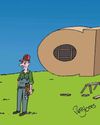
When it comes to male genitalia, there's never been a shortage of information in medical textbooks. Many, many pages over the centuries have been devoted to men's sexual organs. Surgeons are trained to do everything possible to avoid damaging nerves and maintain sensation when operating in the area.
The same cannot be said for the anatomy of women, or the preservation of their pleasure. For hundreds of years - right up until the 1990s - the clitoris was considered so insignificant it was excluded from medical texts. In the 19th century, it was literally excised - surgically removed as a treatment for "hysteria" and other imaginary, female-only ailments. The clitoris was seen as the source of no end of trouble, but also so unimportant that women wouldn't miss its removal.
Unbelievably, it wasn't until 1998, to when Australia's first female urologist, Professor Helen O'Connell, studied the clitoris in detail and published her findings, that the full, accurate anatomy of the organ was known. In 2005, she mapped the clitoris using MRI imaging, and has since created a full three-dimensional model.
O'Connell discovered that medical science had it wrong about the clitoris. It was assumed that what was visible externally - the glans - was basically all there was to it. But she found that, like an iceberg, the clitoris goes far deeper and wider.
Beneath the pubic bone, unseen, it extends out from the glans in a wishbone shape; it has "legs" surrounding eggplant-shaped bulbs that extend up to 9cm on each side.
Viewed in 3D, the whole thing looks like a beautiful, curvy and complex moth orchid. It's all erectile tissue, highly sensitive and capable of arousal. And it's all surrounded by a "very large" network of nerves stretching out like tendrils. Late last year, US researchers counted these nerves for the first time: there are more than 10,000 in this one small area.
Denne historien er fra March 4-10 2023-utgaven av New Zealand Listener.
Start din 7-dagers gratis prøveperiode på Magzter GOLD for å få tilgang til tusenvis av utvalgte premiumhistorier og 9000+ magasiner og aviser.
Allerede abonnent ? Logg på
Denne historien er fra March 4-10 2023-utgaven av New Zealand Listener.
Start din 7-dagers gratis prøveperiode på Magzter GOLD for å få tilgang til tusenvis av utvalgte premiumhistorier og 9000+ magasiner og aviser.
Allerede abonnent? Logg på

First-world problem
Harrowing tales of migrants attempting to enter the US highlight the political failure to fully tackle the problem.

Applying intelligence to AI
I call it the 'Terminator Effect', based on the premise that thinking machines took over the world.

Nazism rears its head
Smirky Höcke, with his penchant for waving with a suspiciously straight elbow and an open palm, won't get to be boss of either state.

Staying ahead of the game
Will the brave new world of bipartisanship that seems to be on offer with an Infrastructure Commission come to fruition?

Grasping the nettle
Broccoli is horrible. It smells, when being cooked, like cat pee.

Hangry? Eat breakfast
People who don't break their fast first thing in the morning report the least life satisfaction.

Chemical reaction
Nitrates in processed meats are well known to cause harm, but consumed from plant sources, their effect is quite different.

Me and my guitar
Australian guitarist Karin Schaupp sticks to the familiar for her Dunedin concerts.

Time is on my side
Age does not weary some of our much-loved musicians but what keeps them on the road?

The kids are not alright
Nuanced account details how China's blessed generation has been replaced by one consumed by fear and hopelessness.